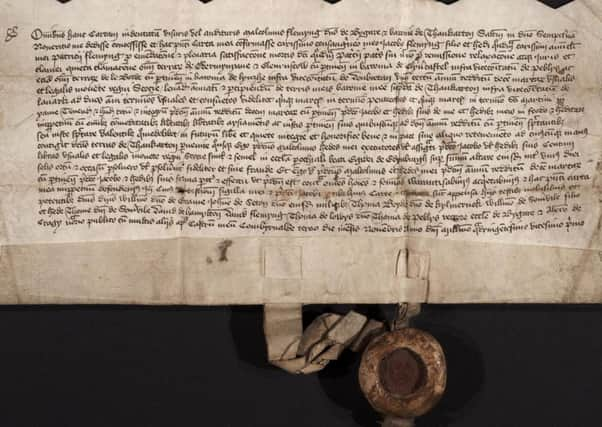A dark tale of corruption and murder


The killer or killers can never face Scottish justice, because the dark deed in question happened six centuries ago.
A new study of 15th century charters may have uncovered the truth behind a major local property agreement that reeks of murder, complicity and ruthless coercion.
Advertisement
Hide AdAdvertisement
Hide AdThe evidence points squarely to an ambitious man, baron Malcolm Fleming, being willing to resort to extreme violence to gain property, power, and prestige.
And the murky story is “hidden in plain sight” within legal documents, signed and witnessed in the former Cumbernauld Castle.
The remarkable evidence of medieval skulduggery has been welcomed by local man Adam Smith, chairman of Friends of Cumbernauld House Park.
He has previously managed to interest former Time Team producer Tony Robinson in the one-time castle, although that series has now finished.
Advertisement
Hide AdAdvertisement
Hide AdThe 15th century was a violent and turbulent time for Scotland, and the reigning king at the time of the deed, James I, was himself murdered by conspirators in 1437.
The breakthrough in what’s being seen as Cumbernauld’s own medieval murder mystery has come from a recent donation to the University of Toronto’s Thomas Fisher Rare Books Library.
In it are no less than 60 historical charters, of which one may hold the key to a killing.
It is dated November 3, 1421, and is for Cumbernauld Castle, which was ultimately replaced by the 18th century Cumbernauld House we see today.
Advertisement
Hide AdAdvertisement
Hide AdThe charter was used to formally grant James Fleming his father’s land, following allegations of murder, and was signed by his cousin Malcolm Fleming, Lord of Biggar and holder of the barony of Cumbernauld.
Professor Michael Brown, Professor of Medieval Scottish History at the University of St Andrews, has said this was no simple property deal but involved “a degree of coercion of the lesser man, James Fleming, by his more powerful cousin”.
Direct evidence of the extent of this coercion is provided by a final document.
In this, James Fleming clears Malcolm Fleming of Biggar and his accomplices of any part in the death of his father, Patrick Fleming, and agrees to end any hostility towards Malcolm.
Advertisement
Hide AdAdvertisement
Hide AdIt could be Malcolm and his henchmen were being allowed to get away - literally - with murder, while being handed a rich prize.
Professor Brown adds: “It is surely not a huge stretch to suggest that Patrick Fleming had been killed in a dispute over his estates and that, after his death, his son was being forced to surrender the lands in question to a man implicated in the killing.”
He adds: “There is undoubtedly more to this story to be revealed and the analysis of the other documents in the collection will be a vital part of this”.
Commenting on what could be damning evidence of medieval high society murder and coercion, Adam Smith said:“The discovery and analysis of these documents is fascinating and helps us to understand a little more about medieval life in Scotland, and the Cumbernauld area.
Advertisement
Hide AdAdvertisement
Hide Ad“Cumbernauld Castle is thought to have been an impressive structure with a rich history, and we hope to learn more even in the near future”.
More on the “investigation” into the dark deeds at 15th century Cumbernauld Castle can be found online at http://flemish.wp.st-andrews.ac.uk.
The next meeting of the Friends of Cumbernauld House Park will take place on Monday, June 8 at 7pm in Cumbernauld Theatre.